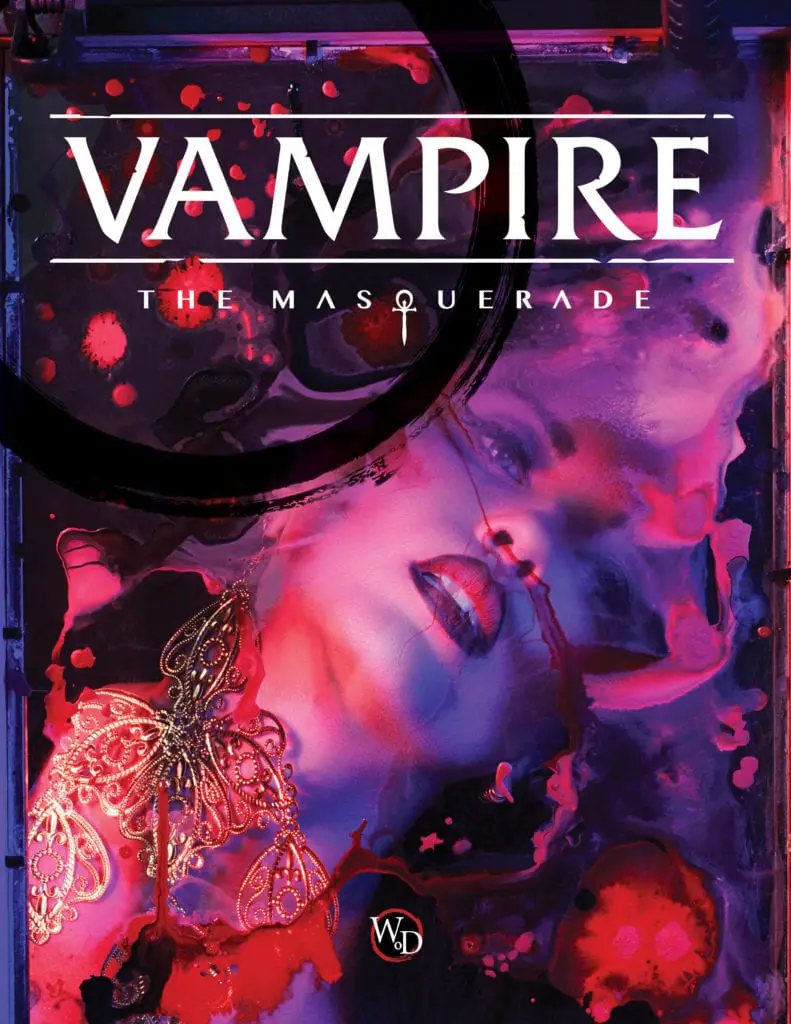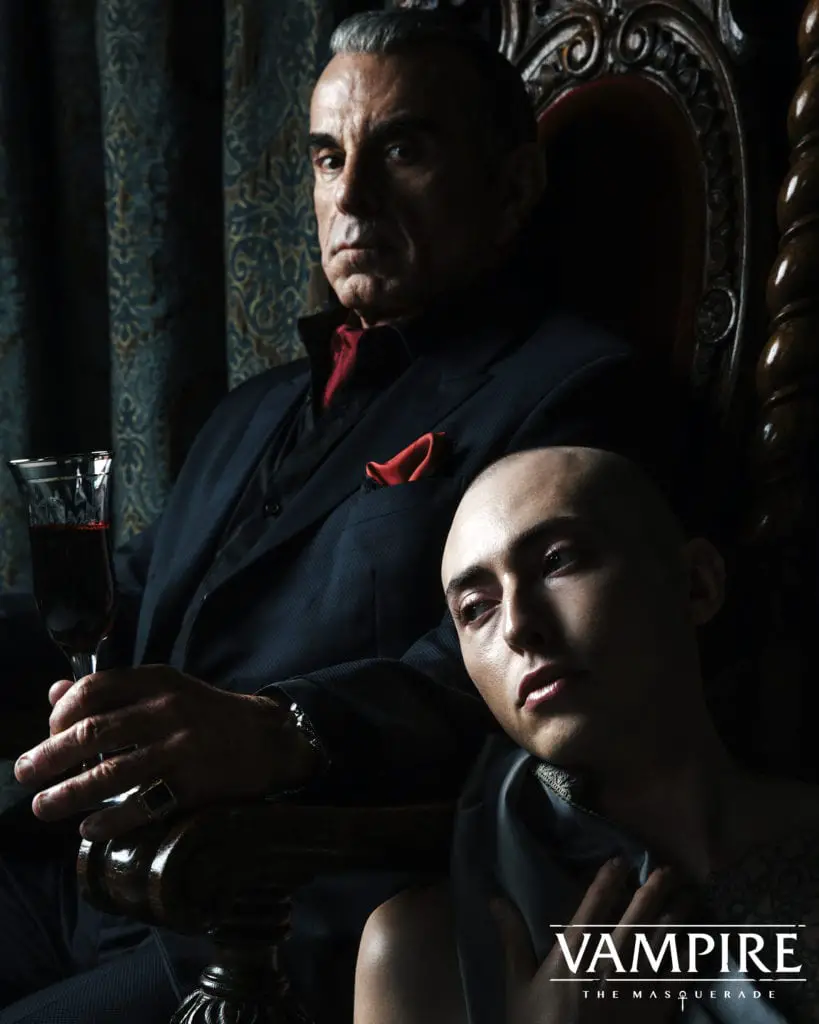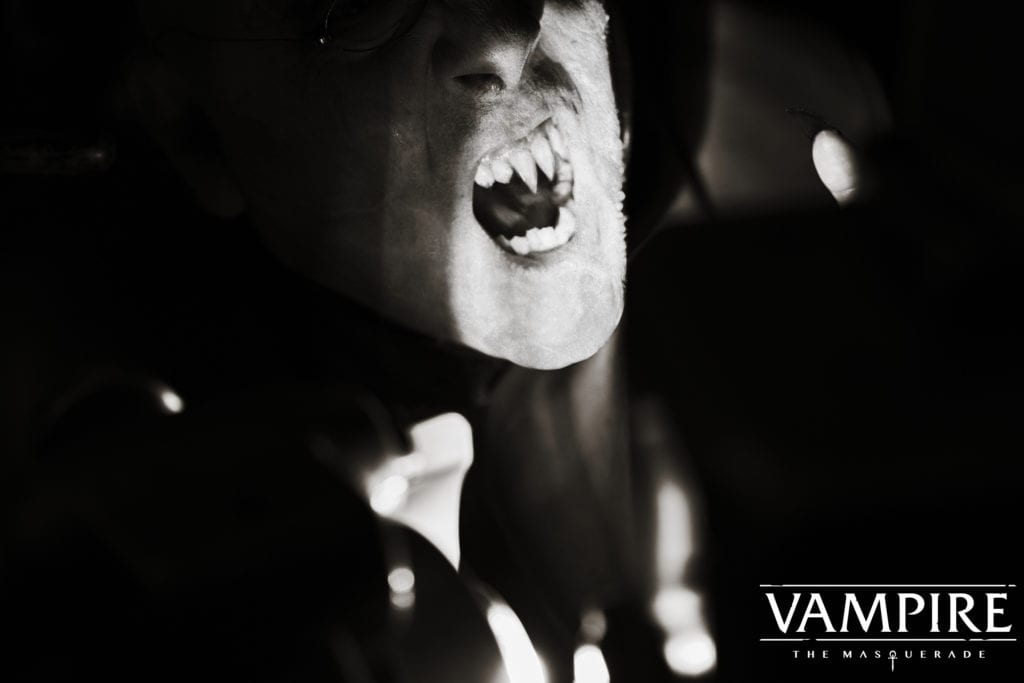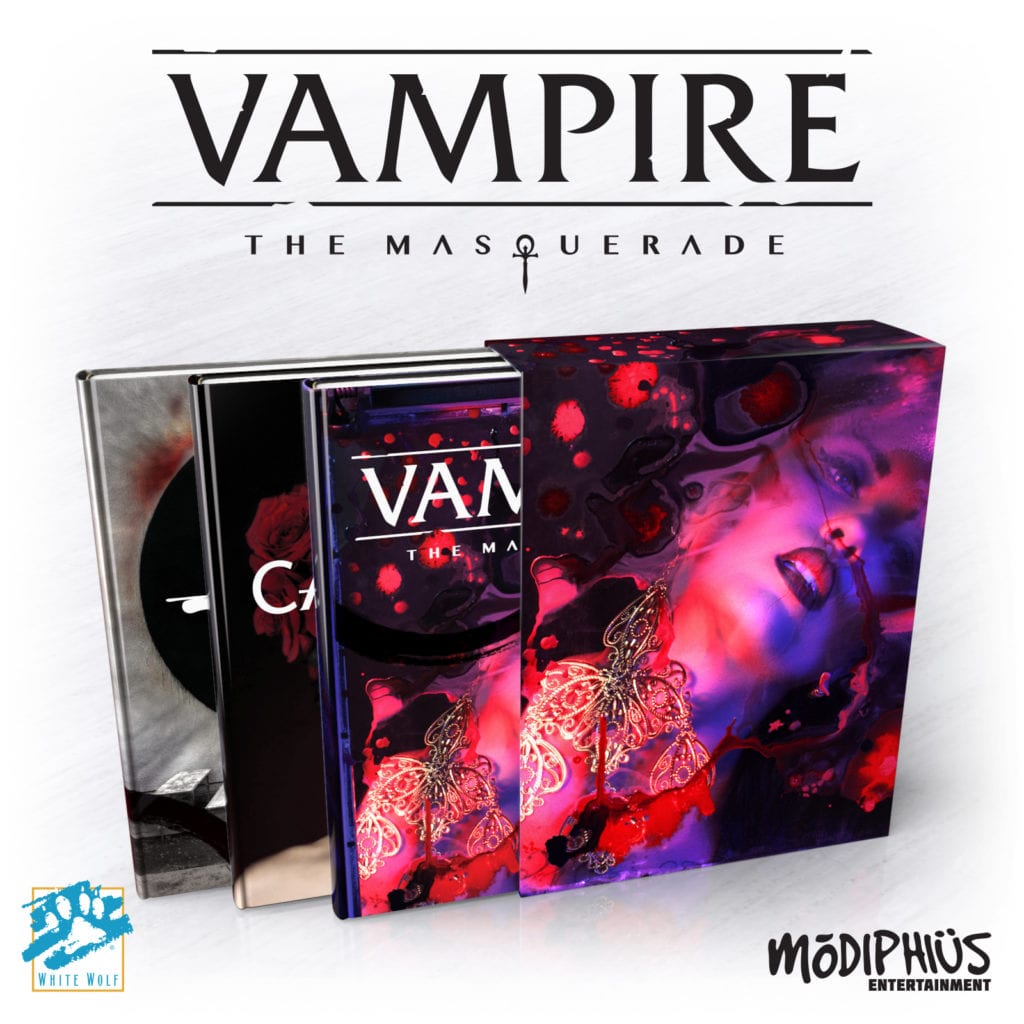It’s been seven years since the last version of Vampire: The Masquerade debuted, the longest gap between editions since the game debuted in 1991. The vampire-shaped void in White Wolf Publishing’s World of Darkness setting was filled by Masquerade’s companion and ostensible successor: The Requiem. But after all that time, people still wanted Masquerade. And so, as their first project after being bought by Paradox Interactive, White Wolf debuted Vampire: The Masquerade, Fifth Edition at GenCon.

I was lucky enough to meet with a pair of developers who worked on 5e: Karim Muammar, Editor In Chief at White Wolf, and Jason (not Lorenzo) Carl, Producer. We had a great chat about how the new edition was developed, what thoughts went into changing the game, how vampires are adapting to the 21st century, and how White Wolf got back to its roots.
Dan: So tell me a little bit about what you two put into the creation of V5?
Karim Muammar: I oversaw the writing as well as the system designs, mainly the vampiric system, which is the hunger system, and all the different powers of the blood and so on.
Jason Carl: My role was as Producer, a role that sits between creative and business and has operational oversight for the project. Budget, scheduling, resources, that sort of thing.
Dan: It’s been a few years since the last edition of Vampire, the last one being released in 2011. Has this been in development for that long or is there a reason to bring it back now?
JC: Man, seven years would be awesome! Wouldn’t you love having had seven years to work?
KM: Imagine what we could have done in seven years!
JC: Can we do that?
KM: You know what, let’s do that for Werewolf, yes?
JC: Seven years, that sounds reasonable.
KM: What we actually did here, me and Martin Ericcson the Lead Storyteller, we did a lot of preliminary work in 2016 and 2017, thinking about what kind of game we wanted it to be. But past the meta part, what we wanted to bring to the fore, what we wanted to add to it, what we wanted to see as separate projects, as well as what types of rules we wanted to see. What kind of system, to what extent we would adhere to the old system, to what extent we would try to renew things. I think the actual writing process, that really started about a year ago.
JC: I think the whole development cycle, from beginning to end, is almost eighteen months, but about a year of really intense development on the aspects of the game that you see in the book.

Dan: What inspired you to bring it back? It obviously has enduring popularity, but why bring it back after such a long gap between editions?
KM: I think the reason is that as White Wolf was purchased by Paradox Interactive, we felt that we sort of had to “carry the torch” forward for the centerpiece of this transmedia brand that we were trying to create out of White Wolf. So we are looking at more than tabletop role-playing games. We’re looking at board games, we’re looking at card games, we’re looking at books, we’re looking at video games, naturally-
JC: Films, TV, Comic books.
KM: Exactly! But all of these need a strong centerpiece. So we wanted to go back to where it all began: a tabletop role-playing game. And really, we’re really inspired by the first edition of Vampire: The Masquerade, that when it came out it revolutionized everything. A completely new look different from every other game, a completely new setting, a new feel and a new way to play tabletop role-playing games.
JC: I think that there’s a reason. It’s that once we settled on it, we realized that we still have plenty of stories in this world to tell. Vampires are still very relevant to the world around us and what’s happening today, globally. This is still a very rich storytelling experience, with an infinite amount of stories to tell.

Dan: So you drew inspiration from the first edition that came out in 1991, and obviously with this sort of genre, as you say, ties heavily into contemporary things. As well, gaming tastes and habits have changed since then. What are some of the things you’ve added or changed about Masquerade that reflect the world in this new edition?
KM: I think one thing that has changed is gaming technology and the way to play tabletop RPG’s, there’s more expected of the players. Games today have a much more modern rule set, that is often less “simulationist,” and more narrative or “gameist.” So what we wanted to do with this game is create a game where the rules did not interfere with the story, but rather created the story, so that every single roll has the potential for drama, excitement, and even tragedy.
So we started with the parts that worked. The dots, the d10s (we couldn’t change that or else it wouldn’t be Vampire: The Masquerade). But we wanted to look at how these things actually translate to the table experience. Instead of rolling five times per interaction, we wanted to take it down to one. Instead of [an] initiative to hit, damage, soak, you’d instead make a single role for an engagement, any engagement, whether it be a physical engagement or a social engagement.
But we also wanted to make it clear to the player that you are playing a vampire. Thus, we came upon “The Hunger” system, which is a way to introduce “The Hunger” as a constant in every single roll. The hungrier you are, the more your dice are going to turn into Hunger dice, which carry with them the possibility for tragedy or violence or just great drama that comes with being a monster, especially a hungry one.
JK: We also obviously updated how the book looks, visually. That was really important to us. When you look back at the first edition of Vampire, it’s easy to forget the impact that it made on the eyes. It looked like a rock n’ roll album with it’s black and white cover, visceral colors, and real people as vampires. And we wanted to be sure that v5 has the same visual power as the original. So we decided to include a lot of very high-quality photography to show what real vampires look like today, but also drawings, sketches, pictures, graphic design digital art, in a really interesting visual mix in order to reflect the World of Darkness as it is today.
We were very fortunate because our layout artists were Free League, a Swedish design company who’ve been winning awards for Tales From The Loop and Mutant Year Zero. Just incredible design that you’re going to see in this book, just interesting design layouts; you’re going to see infographic charts, you’re going to see information laid out in a way that’s easy to read. It makes the game easier to learn and teach that way, too. It all works together with the art and the design to give the whole book a very sleek, very modern, and contemporary look.

DA: So you’ve changed the mechanics, but let’s talk about the setting, the World of Darkness itself. How has it changed in the way you’ve written and conceptualized it to fit into more modern sensibilities?
KM: I will say it has progressed.
JC: This is not a reboot.
KM: Yes, it has progressed, nothing has changed as in being retconned, but the story has moved forward so that the vampires are caught up in the events of the modern world. They are being hunted by what is called the Second Inquisition, which is a result of the War on Terror getting a whiff of these strange anomalies, Swiss bank accounts, and people disappearing.
JC: People who don’t show up in airport scanners…
KM: Exactly, exactly. The kind of people, they call them “blank bodies” because they don’t show up on scans, they don’t have a body. That means that vampires are hunted to a much larger degree than they were previously.
JC: And we all know how that turned out. Look, it’s a terrible time to be a vampire. People are walking around at night with one of these “phone” things with a camera on it. There are closed circuit TV cameras everywhere. There are biometric scanners and its impossible to get through an airport without a screening. So vampires really have to adapt to a modern world that is changing fast both technologically and culturally, or they’re going to be hunted and killed.

KM: Or they recoil like the Camarilla does (EN: the Camarilla are the most conservative sect of vampires, working the hardest to maintain the Masquerade and keep vampire society as it is) and disavow technology, trying to return to a feudal age.
DA: Vampire Amish, basically.
JC: Exactly. If the Prince of Chicago wants to talk to a vampire in Boston, whereas in the 90’s he’d have just picked up a phone and called him…that’s too dangerous now. Who’s listening? Now, he’s got to write or send a coded message or find a neonate.
KM: Exactly. He might get a coterie to act as his messenger.
JC: “Hey you, standing over there in Elysium (EN: A place where vampires may gather without fear of discovery or harm), go to Boston!”
KM: At the same time, there’s also “The Beckoning,” a mysterious force that is calling all vampires of a certain generation to the Middle East as the Antediluvians (EN: The god-like eldest vampires and mythical founders of the thirteen clans) either might be rising, or might be threatened by the Sabbat (EN: Militant vampires bent on destroying the Antediluvians at Gehenna, the vampire Armageddon said to take place in the Middle East) of the Gehenna Crusade, leaving gaps in the Camarilla’s power structure that can be exploited by an ambitious coterie. So all these changes have been made to give the players agency with the way they can interact and have a bigger impact on the setting. Rather than just being constant lapdogs.
JC: Something that Karim mentioned that is expanded on the rules set as well is that the vampire factions are again in conflict. The Camarilla and the Anarchs (EN: Vampires who reject the rigid rules of vampire society) have been pulled apart, their political alliance has been destroyed. Clans have left the Camarilla and moved to the Anarchs and in future products, you might see new clans join the Camarilla. So vampire society really reflects the turmoil of the real world today.

DA: It sounds like you’ve really embraced the more globalized world we live in now. It sounds like there’s been a lot of globalizing and internationalizing of the Masquerade.
JC: There is. We consider ourselves a global company, and we consider our game to be global in nature. It’s very important to use to reflect all the world, so we will move away from the very North American focus and will look at vampires as they are in Europe, in Latin America, in Asia, and Australia. It will be very important [for] us to make sure that we have people who are experts in those cultures writing those books for us.
KM: Write about what you know.
JC: When you see the Chicago By Night book coming from Onyx Press, you’ll see a very diverse team of writers, many of whom live in Chicago, and work there, and represent very diverse points of view. And we think that’s super important.
KM: We think that credibility and authentic representation of a world [are] important. What was most striking, for me about the first Vampire was how real it felt. It felt genuine and rooted in the real world.
JC: You could believe it.
KM: Exactly. Real authors and real music. You could almost…smell the West Coast, even for me as a Swede living up north. And that also made the vampires more real. They didn’t live in some sort of fantasy vampire strata, but they were firmly anchored in the real world, which made them so much more alluring and interesting to play. And we really wanna push that there.

DA: It sounds like you have a lot for new players, but also a lot for players who have been with you since 1991.
JC: I think that players who have always loved Vampire are still going to love it, and I think it’s going to match their expectations for how games are designed and played. But we are seeing very positive reactions from people who have never played Vampire before, who didn’t even know it existed, and they are eager to play a game that lets them play the monster in the modern world. And do so in a way that they can share with their friends. We’re pretty enthusiastic that this game will help us grow that community.
DA: So can you give me a little taste of what might be coming next in The Masquerade?
KM: Well we have a couple books coming out this year, the setting books: The Camarilla book and the Anarch book. These will portray two vastly different ways to be a vampire. What it is to be a vampire in a Camarilla, the methods of the Camarilla, and how the Camarilla perceive the outside world, how it ties into both the real world and the world of Vampires. Plus more lore, more sheets, as well as some playable crunch there as well.

And of course the Anarch book, which tells us wildly different stories about vampires outside of the Camarilla. Whether they are trying to live their own lives in various ways, still connected to their families or subcultures, or if they’re organized as part of the Anarch movement fighting a harsh and desperate, but passionate, political struggle against the Camarilla and everything they represent. The Anarch book, looking at some of the initial work, it is a really really incredible book. I’m really looking forward to the books. And they’re also going to have their own distinct art styles that illustrate the themes and the mood of the book.

JC: And of course Chicago By Night, where we will return to where it all began, the setting of the very first Vampire chronicle ever, Chicago, and take a look at what’s been happening there. That’s where we will introduce what’s happening with the Lasombra clan (EN: A clan of predatory social Darwinists who seek to rule other vampires by virtue of their power), who play a pivotal role in what’s happening in Chicago, and the Sabbat. But we’ll also have to turn our attention to Werewolf very soon as well.
KM: But I thought we had seven years?
DA: And that’ll reflect the same sort of changes that we’re seeing in the Vampire books?
JC: Yeah. We’re still at a very early conceptual phase with it so nothing’s set in stone, but yes of course. The werewolf situation is in many ways even more dire than the vampire situation and that will be reflected in the game.
KM: Yeah, I mean, a lot of vampires are thriving in today’s world.
JC: Absolutely, if we could just get rid of the pesky cell phones!
KM: Whereas for werewolves its just much worse.
DA: Thinking back to the present, when will V5 be available for purchase?
JC: This is the worldwide debut at GenCon, the pdf is available right now on worldofdarkness.com, and depending on where you live, your local hobby store could have it on their shelves as early as right after GenCon, but it might be a week or two.
DA: North America and Europe, primarily?
JC: Yes, it’ll take a little longer to reach Australia because basically everything does.

Be sure to keep an eye out for physical copies of Vampire: The Masquerade V5 at your local game shop or, as Jason mentioned, pick up the PDF from their website for $24.99. And keep an eye here on The Fandomentals for our full review of Vampire: The Masquerade including an in-depth look at the story, characters, and mechanics of the game as well as what it’s like to actually play it!
Update: Some of the lore within the editor’s notes has been changed to reflect V5 more accurately. Jason Carl’s name has also been corrected to its proper spelling. Please don’t call the Camarilla on me.

